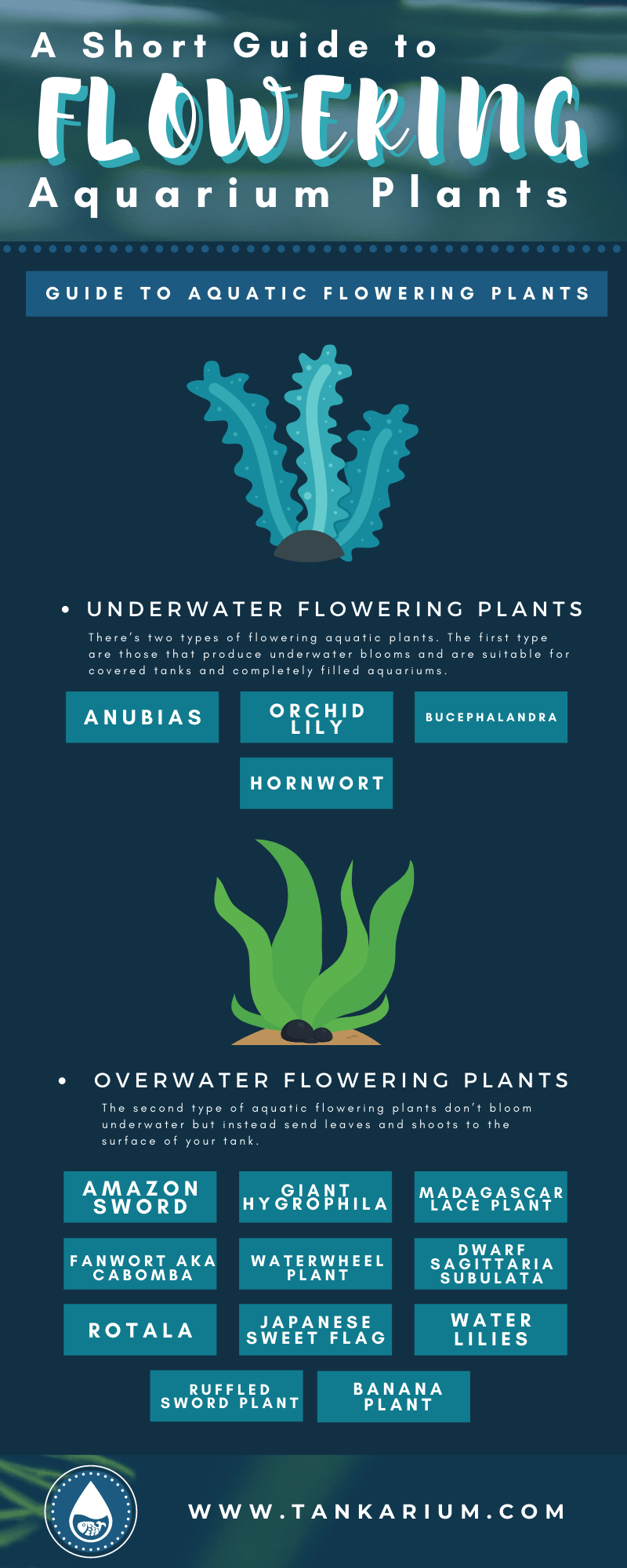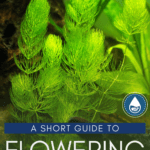Live plants add a lot of texture and tranquility to an aquarium, but what if you’re looking for something a bit more spectacular? Green plants make for a lovely backdrop to any tank, but for surprising pops of color, you should consider adding some flowering aquarium plants to your underwater garden!
Guide To Aquatic Flowering Plants
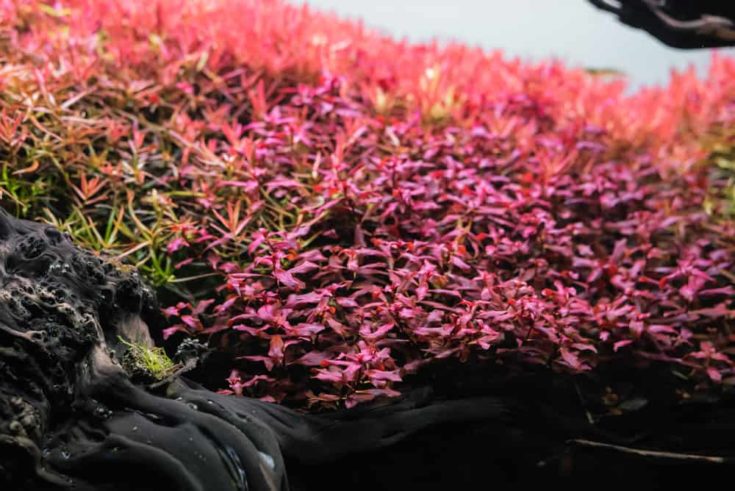
Most of us associate flowering plants with terrestrial gardens and pond ecosystems, but those are not the only habitats where you’ll find these showy blooms. Have you ever wondered what flowers grow underwater, or if there’s even such a thing as aquatic flowering plants suitable for aquariums? Wonder no longer!
If you’d like to add something special and unique to your tank, then this list of flowering aquatic plants could be what you’ve been looking for. I’ve created these detailed profiles of the 15 most popular underwater flowers to help you identify the perfect blooming plants for any aquarium.
Underwater Flowering Plants
There’s two types of flowering aquatic plants. The first type are those that produce underwater blooms and are suitable for covered tanks and completely filled aquariums. These are the most popular underwater flowering plants:
1. Anubias
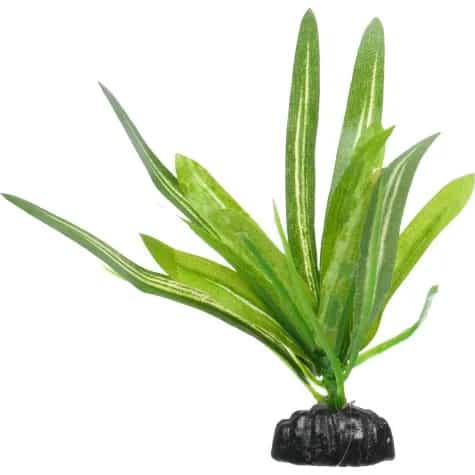
One of the easiest flowering aquatic plants to grow is this hearty African native known as Anubias (Anubias barteri) or Dwarf Anubias. Reaching 7.5 to 16-inches tall depending on the variety, this dark green, wide-leafed plant works well in the foreground of your tank, or you can train it to grow on wood, rocks or decor.
Anubias Growth, Flowers And Propagation
Anubias is a rhizome similar to ginger or turmeric. The leaves, creamy-white flowers and roots spread from nodes along the central rhizomatous stem. You can slip a 2-inch piece with a few leaves under a layer of substrate and it will send roots out to anchor the plant in place, or you can let it attach to decor or even float in your tank.
Anubias thrives easily in most conditions and is an ideal pick for both nano tanks and large densely planted aquariums. It’s an excellent option for novice aquarists, and once it’s established it’s very easy to grow more. Just break off a fresh 2-inch section from the main plant and place it in another part of your tank!
Anubias Care Requirements
Light Requirements
Low to Moderate
Aquarium Size
10 gallons and up
Substrate Requirements
None
Fertilization Requirements
Can use a balanced fertilizer; CO2 recommended
Ideal Water Parameters
72 to 82°F; pH 6 to 7.5
Plant Care in Aquarium
Easy
2. Orchid Lily
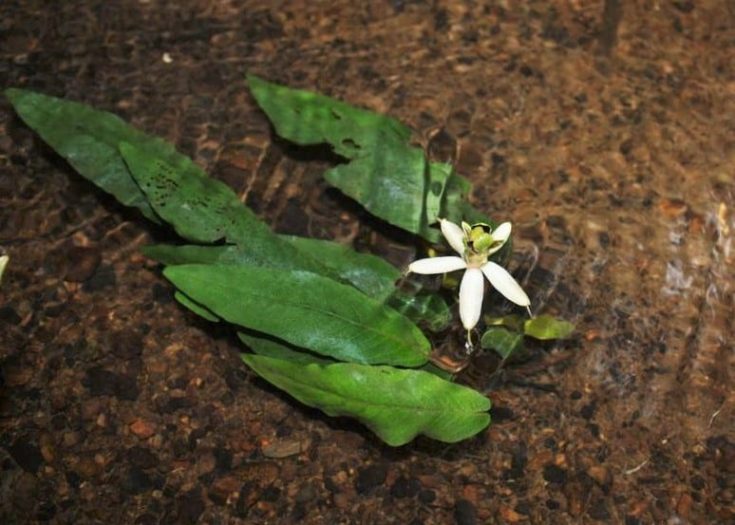
If you’re interested in a rare beauty, this bulbaceous cousin to the lotus might be the next showpiece for your tank. Native to Southeast Asia, the Orchid Lily (Barclaya longifolia) produces stunning green, red and purple foliage. Growing from 17 to 30-inches tall, the Orchid Lily makes a great mid to background aquatic plant.
Orchid Lily Growth Habits
It’s not difficult to maintain Orchid Lilies as long as you’re careful to meet their basic requirements. It’s best to plant them in a high-quality plant substrate or fine gravel and only sink about ½ of the bulb under the surface, or it may rot and die. Their delicate leaves are fragile, so avoid planting in high currents or under a filter outflow.
You don’t have to use a fertilizer or carbon injection system for Orchid Lilies, but your plants will grow larger and may exhibit brighter red and purple colors if you do. They don’t flower often, but if you allow the stem to grow above the water line you may see a few white flowers. They are not easy to propagate, however.
Orchid Lily Care Requirements
Light Requirements
Moderate
Aquarium Size
75 gallons and up
Substrate Requirements
Fine gravel; No more than half the bulb should be buried in the substrate or the bulb may rot
Fertilization Requirements
Balanced fertilizer/CO2 recommended for vivid color
Ideal Water Parameters
75 to 84°F; pH 6.3 to 7.2
Plant Care in Aquarium
Easy to Moderate
3. Bucephalandra
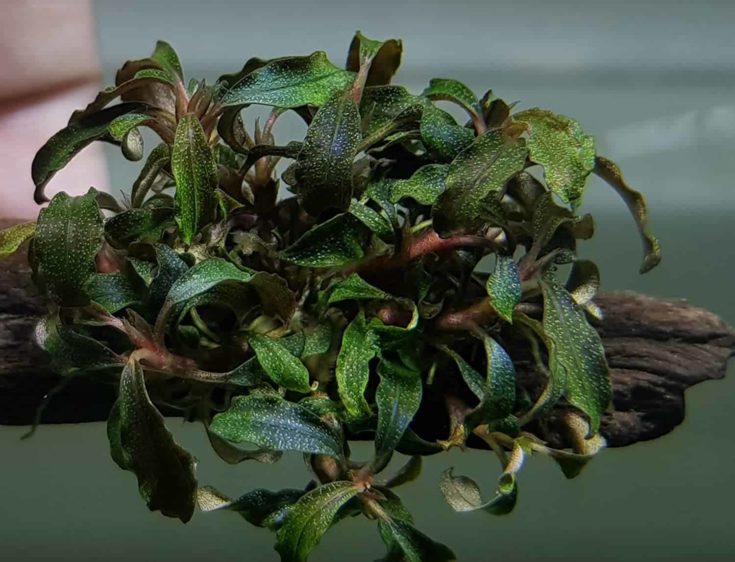
There’s a wide variety of plants that fall under the genus Bucephalandra or “Buce” as aquarists like to call them. These small, slow-growing plants are native to Borneo and have been the darlings of the underwater plant world for years. They rarely grow over 10-inches tall and are suitable for foreground and background in tanks of any size.
Appearance Of Different Buce Varieties
There are more than 200 species in this group and most are sold under varietal names that hint about their appearance, such as “wavy green” or “curly red.” Their leaves may be narrow, broad or curly, and often resemble Anubias.
Buce’s may be green, red, brown, blue, purple or offer a mix of colors at different stages of growth. New growth may be more intensely colored and the leaves can become transparent with age. They often produce small white or pink flowers that peek out just above the level of the leaves.
Buce’s are rhizomes and grow best on your decor, but won’t survive if planted in substrate. They don’t need fertilization, but adding CO2 brings out their most vivid growth and colors. They are prone to developing algae on their leaves, so keep their water clean to prevent outbreaks and reduce nutrients in your water.
Buce Care Requirements
Light Requirements
Low
Aquarium Size
Any
Substrate Requirements
None; only grows on decor
Fertilization Requirements
None; may show more vivid colors with CO2
Ideal Water Parameters
71 to 82°F; pH 6.0 to 7.5
Plant Care in Aquarium
Easy
4. Hornwort
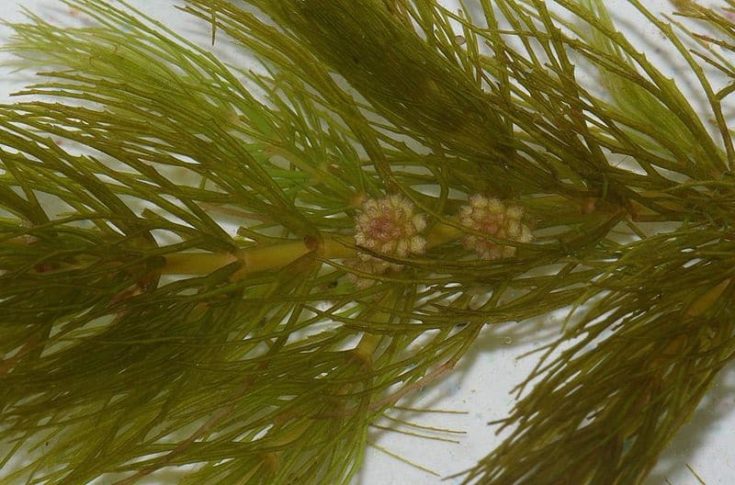
Hornwort (Ceratophyllum demersum) has a name for being an ideal choice for beginners, but I’ll take it further and state that it’s one of the best aquatic background plants overall. This fast-growing species devours the nutrients in your tank and quickly cleans and oxygenates your water.
Hornwort Appearance And Growth
It’s also known as the coon-tail plant because the needle-like leaves grow out in whorls around the stem and resemble raccoon tails. It’s a North American native that’s also extremely invasive. You’ll find hornwort free-floating in lakes, ponds, and streams on every continent except Antarctica.
These green plants spread quickly in most tanks and require heavy pruning to keep their growth under control. A single plant can grow up to 10-feet! You can float it on the surface of your tank or plant it in the substrate along the back. It may inhibit the growth of nearby plants, though, so give it some space.
Hornwort doesn’t need anything special to thrive beyond a good filtration system and plenty of light. It takes in a lot of nutrients, so use a balanced fertilizer if growing other types of plants, too. It isn’t the most impressive flowering plant, however. The small brown flowers are 2mm in diameter and don’t really stand out against the leaves.
Hornwort Care Requirements
Light Requirements
Moderate
Aquarium Size
10 gallons and up
Substrate Requirements
None
Fertilization Requirements
None
Ideal Water Parameters
58 to 86°F; pH 6.0 to 7.5
Plant Care in Aquarium
Easy
Overwater Flowering Plants
The second type of aquatic flowering plants don’t bloom underwater but instead send leaves and shoots to the surface of your tank. If your tank is uncovered or not completely filled, you may be able to see them bloom right above the water line!
5. Amazon Sword
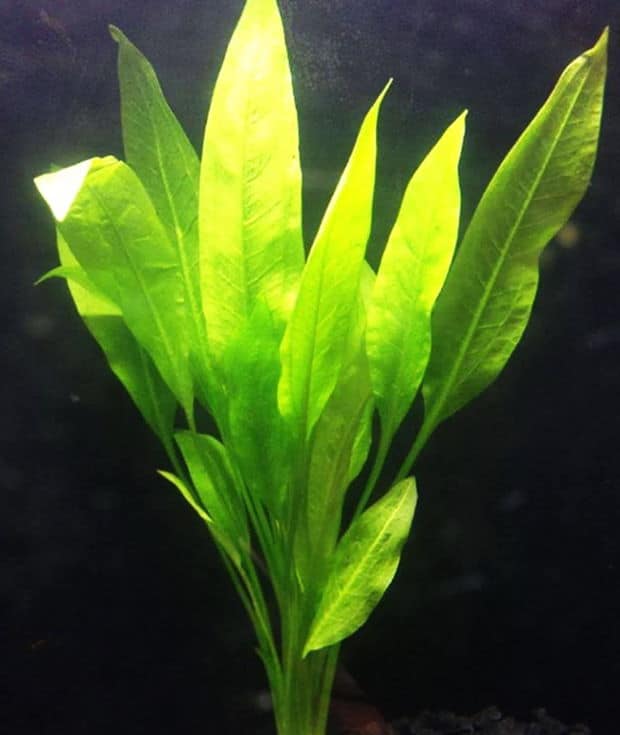
With its large sword-shaped, emerald green leaves and strong root systems, the Amazon Sword plant (Echinodorus grisebachii/amazonicus) often becomes the dramatic focal point of a large tank. They can easily reach 16 inches in height, and their runners produce pretty white flowers if you let them grow above the water line.
Maintaining Amazon Sword Plants
These plants have very short stems and long leaves, which gives them a bushy appearance. They grow from the center out and have a wide root system. Native to the Amazon Basin, these sturdy aquatic plants tolerate a wide range of conditions as long as certain needs are met. They don’t need fertilizer but good aeration is a must.
Sword plants need at least 2.5 inches of aquarium gravel and usually do best when planted in the center of a tank rather than at the edges. They don’t like soft water and prefer a higher mineral content. They are not picky about the temperature, but they do need very fresh well-filtered water that’s frequently changed.
Amazon Sword Care Requirements
Light Requirements
Low to Moderate
Aquarium Size
10 gallon tall and up
Substrate Requirements
Gravel at least 2.5-inches deep
Fertilization Requirements
None needed but a balanced fertilizer is ideal
Ideal Water Parameters
60 to 82°F; pH 6.5 to 7.5; 8 to 15 dGH
Plant Care in Aquarium
Easy
6. Giant Hygrophila
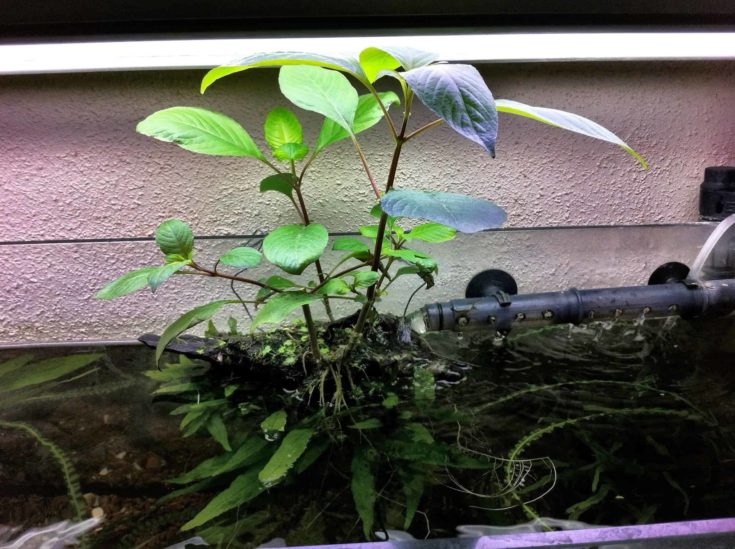
The Giant Hygrophila (Hygrophila corymbosa) is one of the 30 to 50 varieties of hygro aquarium plants and is one of the most popular varieties in the trade. While it can reach up to 25-inches in the wild, most aquarium specimens only hit about 5-inches tall, making them good options for fore and mid-tank arrangements.
Appearance And Maintenance Of Giant Hygro
Like the other hygro varieties, Giant’s are fast-growing plants that quickly spread throughout your tank. Their bright green leaves are long, narrow and have sharp lance-like points. They are prone to iron deficiency and do best planted in a rich substrate with additional nitrogen-based fertilizer and CO2 injection.
While Giant’s are primarily green, using fertilizer and especially CO2 brings out some show-stopping red and bronze tones in the foliage. Heavy pruning also deepens the colors and helps your plant thrive. Unless you allow it to grow above the waterline, though, you’ll probably not have any pink or purple flowers blooming.
Giant Hygro Care Requirements
Light Requirements
Low to Moderate
Aquarium Size
Any
Substrate Requirements
Iron-rich substrate is best
Fertilization Requirements
Does best with a nitrogen-based liquid fertilizer and CO2 injection
Ideal Water Parameters
68 to 86°F; pH 5.5 to 8.0
Plant Care in Aquarium
Easy
7. Madagascar Lace Plant
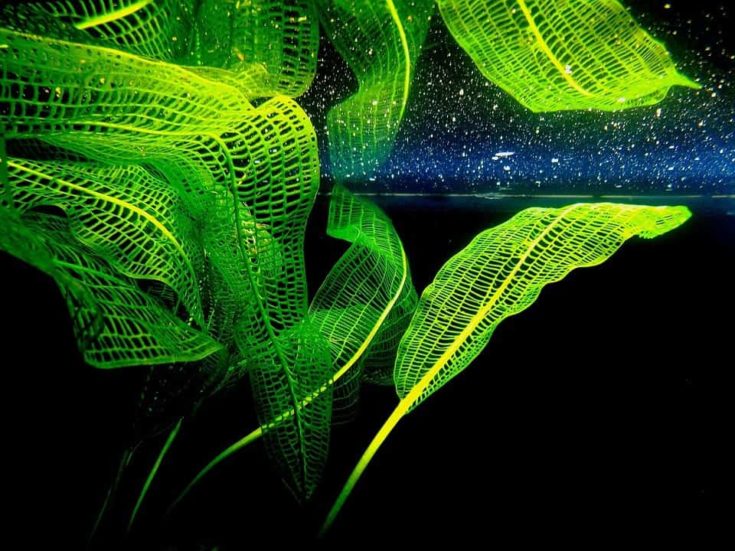
If you’re experienced with aquatic plants and would like a truly unique and beautiful option, then consider the rare Madagascar Lace Plant (Aponogeton madagascariensis). With green leaves and an open network of lacy holes, these 10 to 24-inch plants really stand out in the background or middle of your planted tank!
Lace Plants Are Challenging To Grow
These tuberous rhizomes have a reputation for being difficult to raise, but as long as you understand their needs they aren’t as hard as their rep makes them out. Lace plants need a rich substrate, and the tuber should only be partially covered. They prefer cooler temperatures, but during their dormancy, they like things warmer.
Originally, we didn’t know these rhizomes had a dormant summer period where they lost all their leaves, and many folks tossed their tubers thinking they were dead. If you increase your temperatures and keep applying fertilizer and CO2, your rhizome will sprout new leaves and may even produce white flowers above your water line.
Lace Plant Care Requirements
Light Requirements
Low to Moderate
Aquarium Size
10 gallons and up
Substrate Requirements
Iron-rich gravel or fine gravel
Fertilization Requirements
Balanced fertilizer with trace elements and CO2 injection
Ideal Water Parameters
65 to 74°F with warmer summer resting period at 76 to 82°F; pH 6.5 to 7.5
Plant Care in Aquarium
Moderate to Hard
8. Fanwort aka Cabomba
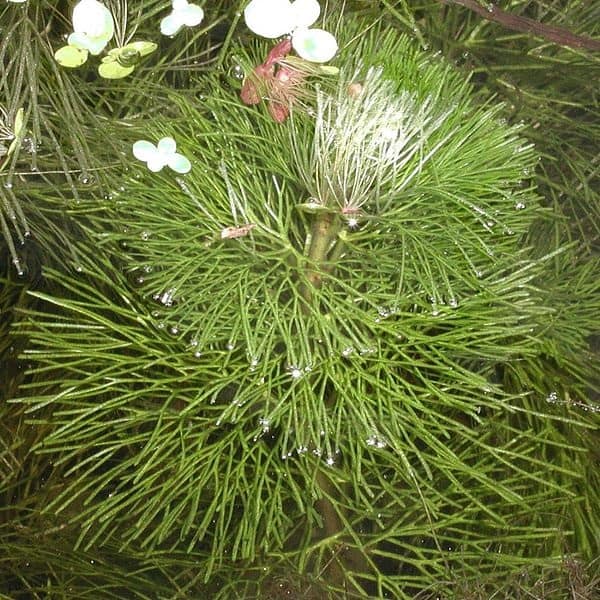
Fanwort is the catch-all term for a variety of fine-leaved Cabomba plants (Cabomba carolinia) native to the Southern US. Green Fanwort is the most common and easiest variety to keep, while the red and purple types are trickier and better for experienced aquarists. These feathery plants are ideal as a backdrop for any tank!
Fanwort Growth And Propagation
Fanworts are stem plants that grow easily from cuttings. Just place a 2-inch or larger section in your fortified plant substrate and it will quickly take root. It’s a fast-growing plant that rapidly takes in nutrients, so fertilizer applications and plenty of light are needed for it to thrive. CO2 injection is especially helpful for the red/purple varieties.
Fanworts rarely flower in aquariums, but if you allow the stems to break the water you might see some white, purple or yellow flowers. They prefer very clean, filtered water with a gentle current. The delicate stems are easily broken, so avoid planting in heavy currents or by your filter outflow.
Fanwort Care Requirements
Light Requirements
Moderate to High
Aquarium Size
10 gallons and up
Substrate Requirements
Iron-rich gravel or fine gravel
Fertilization Requirements
Balanced fertilizer with trace elements; CO2 injection ideal, especially for the red/purple varieties
Ideal Water Parameters
72 to 82°F; pH 6.5 to 7.5
Plant Care in Aquarium
Easy to Moderate (red/purple varieties are harder)
9. Waterwheel Plant
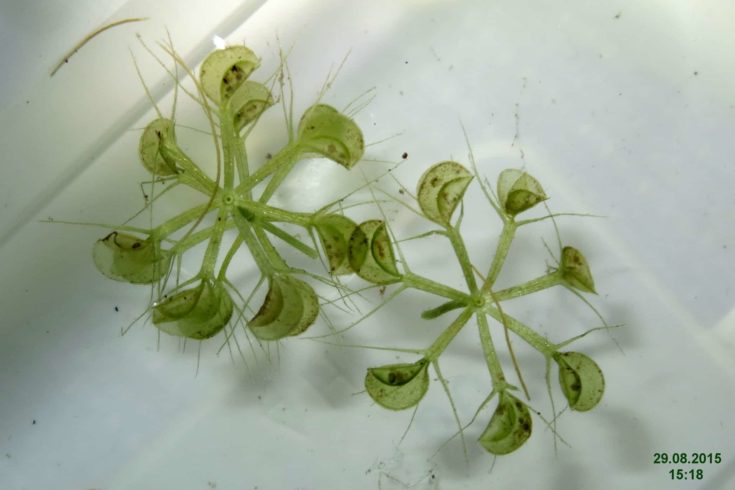
If you’re up for a challenge, the carnivorous Waterwheel Plant (Aldrovanda vesiculosa) is an interesting option for a large, brackish tank. These free-floating plants have small traps arranged in a wheel-shape around the central stem, similar to a Venus Flytrap. They capture and eat microscopic aquatic invertebrates!
Maintaining Waterwheel Plants
Waterwheel plants are not easy to maintain in aquariums and do much better in outdoor ponds. They need a peat-based substrate with a lot of leaf litter, but prefer low nutrients, plenty of CO2 and very clean, filtered water. They can’t compete with algae, so keeping up on your water changes is a must for these plants.
You’ll have to maintain populations of aquatic invertebrates like Daphnia and protozoans to feed your Waterwheels, which means it’s best to keep them with other pond plants like Cattails and Water Lilies. They rarely produce their white flowers in an aquarium and need prolonged periods of high (90°+) temps to bloom.
Waterwheel Plant Care Requirements
Light Requirements
Moderate to High
Aquarium Size
30 gallons and up
Substrate Requirements
Peat substrate with a heavy layer of decaying leaf material
Fertilization Requirements
Requires CO2 injection
Ideal Water Parameters
Brackish or Bog set-ups; 5 to 86°F; pH 5.0 to 6.5
Plant Care in Aquarium
Hard
10. Dwarf Sagittaria Subulata
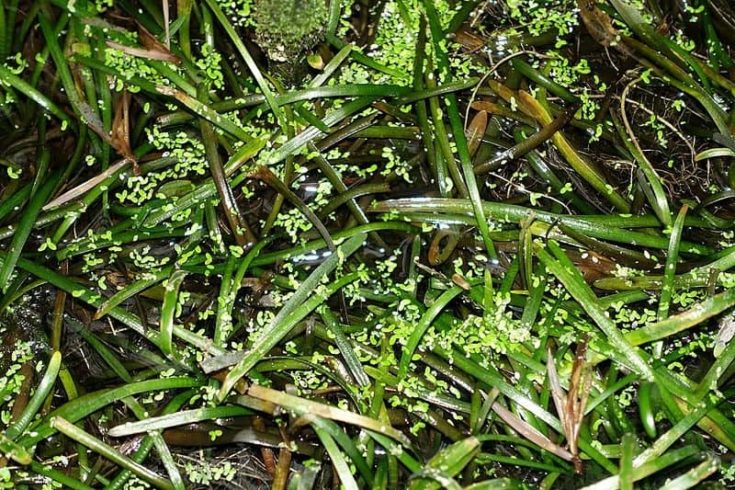
Another plant that likes to flower above your tank’s waterline, the Dwarf Sagittaria (Sagittaria subulata) is very forgiving and not especially picky about its conditions. It can tolerate hard and soft water and a higher pH than many others. Its thin green leaves can grow 12-inches tall, and it makes a great foreground or carpeting plant.
Sagittaria Is An Easy Plant To Maintain
Dwarf Sag spreads by runners, so it’s very easy to propagate. It prefers a rich plant substrate, and iron deficiency is a common problem. If the leaves start to turn yellow, increase your fertilization and add more iron and trace minerals. You don’t have to use CO2 injection, but if you do you’ll see a boost in growth.
Dwarf Sag grows well under moderate lighting conditions, but if you’re using CO2 it may need high lighting to support the extra growth. It’s an excellent choice for planted community and brackish tanks. When it’s ready to bloom, you’ll see egg-shaped leaves floating on the surface followed by small, white flowers.
Dwarf Sagittaria Care Requirements
Light Requirements
Moderate to High
Aquarium Size
10 gallons and up
Substrate Requirements
Fortified plant substrate
Fertilization Requirements
Balanced fertilizer with trace minerals; CO2 not needed but encourages growth
Ideal Water Parameters
72 to 82°F; pH 6.5 to 8.0
Plant Care in Aquarium
Easy
11. Rotala
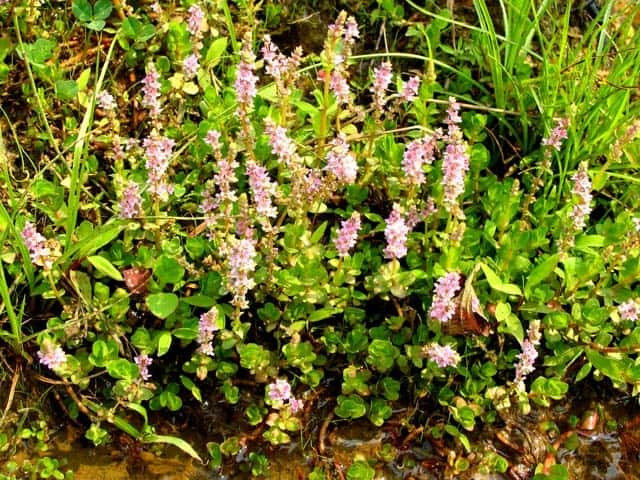
If you’d like to add something to your planted tank with a bit more color, the green to red-colored Rotala rotundifolia is an interesting option. Long considered a classic aquatic plant even though they’ve never come up with a good common name, Rotala is easy to grow but can also present challenges if you want the most vivid coloration.
Growing The Reddest Rotala
Under low lighting conditions, Rotala is a fast-growing bushy green plant that spreads by runners. As the light levels increase you’ll see a pinkish color on the upper leaves closest to the lights, and with intense lighting, the plant turns very red. To bring out the most intense red, however, you’ll need to starve the plant of nitrogen.
You can use liquid fertilizer but avoid adding nitrogen if you’re trying to deepen your reds. CO2 isn’t required, but under high light levels, you’ll see more intense coloration if you use it. This is an excellent option if you’re interested in aquascaping! It often produces small purple flowers that bloom right above the waterline.
Rotala Care Requirements
Light Requirements
Moderate to High
Aquarium Size
10 gallons and up
Substrate Requirements
Gravel
Fertilization Requirements
CO2 ideal for developing a deep red color
Ideal Water Parameters
64 to 86°F; pH 5.8 to 7.9
Plant Care in Aquarium
Easy to grow, but hard to bring out the deepest red colors
12. Japanese Sweet Flag
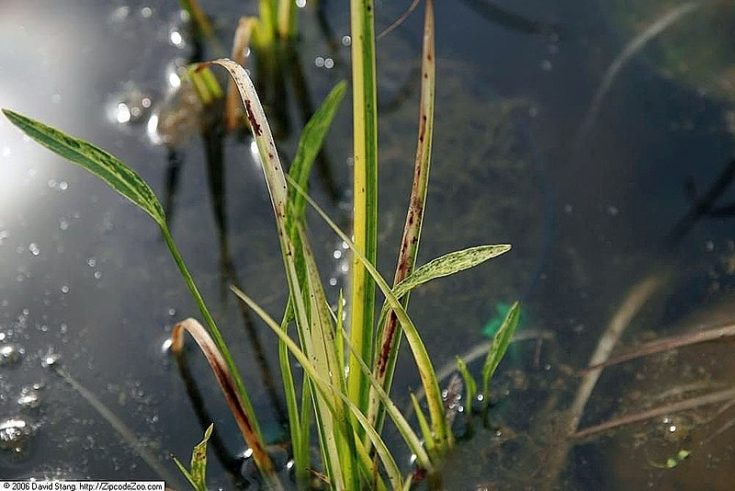
While it’s not a true aquatic plant, Japanese Sweet Flag (Acorus gramineus) is suitable for open-topped tanks or terrariums with aquatic elements. These compact grass-like plants usually don’t get bigger than 12 to 14-inches in height. They prefer to be partially submerged, with their leaves half-way out water.
Sweet Flag Growth Habits
This is an undemanding, slow-growing plant overall as long as it’s kept moist and not completely submerged. It’s a good option for boggy or brackish tanks too. It’s not picky about its substrate and gets its nutrients from your water column, so using a balanced fertilizer and CO2 injection can help promote growth.
You can take cuttings from the base and plant them elsewhere to propagate, and if left to it’s own it will slowly take over your tank. It produces green, white or yellowish blooms above the water in the early summer. This isn’t a common aquarium plant but is often seen in botanical gardens and around ponds and bogs.
Sweet Flag Care Requirements
Light Requirements
Low to Moderate
Aquarium Size
10 gallons and up
Substrate Requirements
Gravel
Fertilization Requirements
Balanced fertilizer and CO2 injection
Ideal Water Parameters
60 to 80°F; pH 6.8 to 7.5
Plant Care in Aquarium
Easy
13. Water Lilies
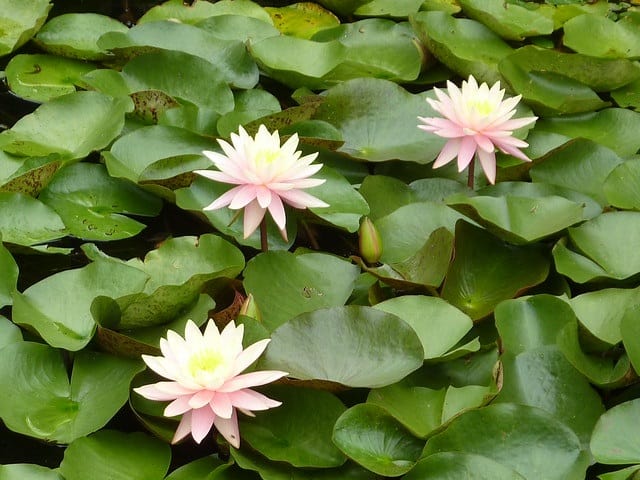
Commonly seen floating in ponds, there are about 60 species of Water Lily in the world and they come in a wide variety of shapes, sizes and colors. They produce magnificent and fragrant blooms which unfortunately only last about 4 days. Water Lilies root in your substrate and spread their leaves over the surface of your tank.
Basic Water Lily Information
Each type of lily will have its own unique needs and requirements, so you’ll have to research the species you’re interested in to see if they will work with your tank. You’ll definitely need a large tank at least 50-gallons in capacity with a layer of aquarium soil. It’s best to fertilize with slow-release tabs placed by their root balls.
Regular trimming will keep your lilies healthy and prevent overcrowding, and frequent water changes will keep the nitrates low, as lilies prefer. They are prone to pests and parasites and often do best when kept with mosquito fish or otocinclus catfish to prevent damage from algae.
Water Lily Care Requirements
Light Requirements
Moderate to High
Aquarium Size
50 gallons and up
Substrate Requirements
Aquarium soil
Fertilization Requirements
Slow-release tabs placed by root ball when planting and replenished every 2 months
Ideal Water Parameters
Varies widely depending on the species
Plant Care in Aquarium
Varies by species, but most are Moderate
14. Ruffled Sword Plant
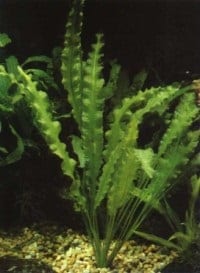
An interesting and dramatic rhizome, the Ruffled Sword Plant (Aponogeton crispus) looks stunning in the back corners or center of a fish tank! It has sword-shaped leaves with curly, ruffled edges that are nearly transparent and range from green to a pale brown color. The Ruffled Sword can easily reach 20-inches in height.
Ruffled Sword Plant Habitat And Growth
Like the other rhizomes on the list, most Sword plants are purchased as bare bulbs you’ll bury part way in your substrate. Soon green leaves will appear, and this slow-growing plant will shoot up in height. The Ruffled Sword is a frequent bloomer, and produces long, above-water flower stalks with white to yellow buds.
As a slow-growing plant, these Swords prefer a rich substrate but do well with regular aquarium gravel as long as you use a balanced fertilizer. They do prefer slightly soft water, and if you have harder tap water or are using moderate to high lighting in your aquarium, you should also consider supplementing your plants with CO2.
Ruffled Sword Plant Requirements
Light Requirements
Low to Moderate
Aquarium Size
20 gallon tall tanks and up
Substrate Requirements
Plant substrate ideal, but tolerant of regular gravel and fine gravels if fertilizer is used regularly
Fertilization Requirements
Balanced fertilizer; only need CO2 in higher light/hard water set-ups
Ideal Water Parameters
60 to 86°F; pH 6.5 to 7.5; prefers slightly soft water
Plant Care in Aquarium
Easy to Moderate
15. Banana Plant
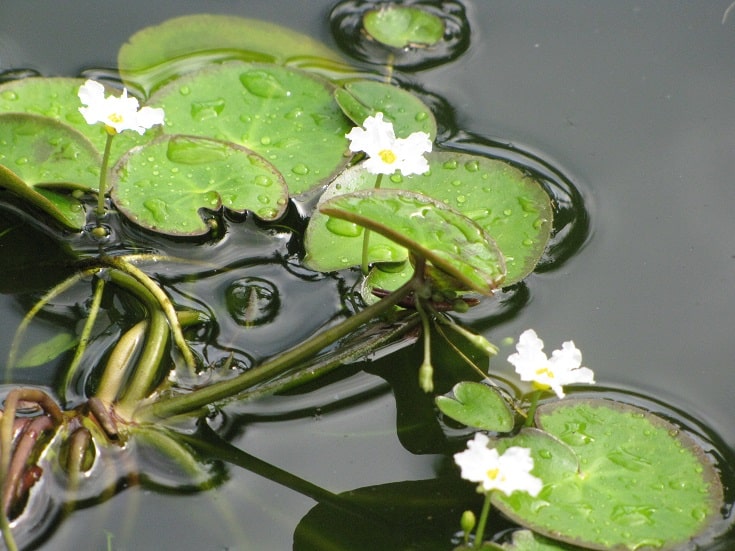
I’ll wrap up this list with a particular favorite of mine, the fascinating Banana Plant (Nymphoides aquatica). This compact species makes an interesting foreground plant, with its banana-shaped tubers and long stem that leads to a broad leaf and tiny white flowers that float on the surface of your tank.
How To Grow A Banana Plant
Planting a banana plant really couldn’t be easier. You can float it in your tank, and it will send down roots into your substrate. Or you can partially submerge the tubers in your substrate and let them root there. Just don’t cover them entirely with a substrate or your plant will die.
You only need to use a fertilizer if your substrate is lacking nutrients, like sand or aquatic gravels. If you’re using a rich substrate, you shouldn’t need to add any extras for these plants to thrive. You’ll see the best growth under moderate light, and most recommend using CO2 as well.
Banana Plant Care Requirements
Light Requirements
Low to Moderate
Aquarium Size
10 gallons and up
Substrate Requirements
None
Fertilization Requirements
Depends on your substrate; use liquid fertilizer with sand or regular aquarium gravel, but none is needed if using plant substrate or aquatic soil; CO2 is recommended
Ideal Water Parameters
68 to 81°F; pH 6.0 to 7.2
Plant Care in Aquarium
Easy
Conclusion
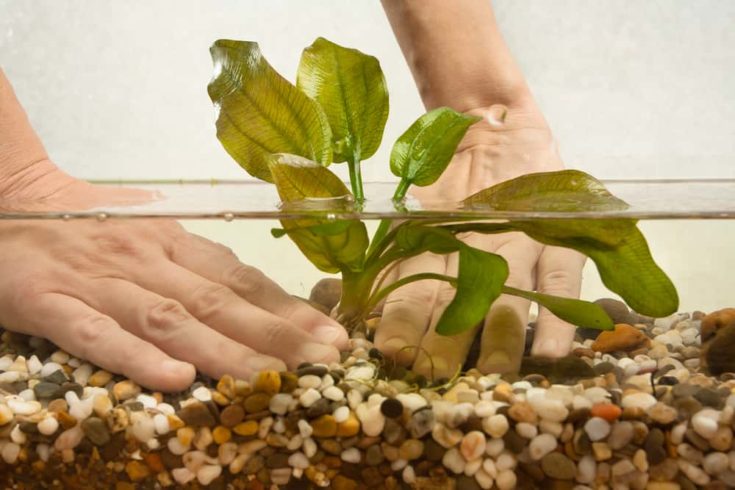
There are two types of flowering aquatic plants: those that bloom underwater and those that send flowers to bloom on the surface of your tank. The best flowering plants for your aquarium will depend on your tank size, light conditions, substrate and water parameters. Most of these plants are very easy to grow, however!
We’d love to hear about your experiences with growing underwater flowers or other blooming pond plants. Share your thoughts in the comments, or join us on our social media pages!
Like to know where you can get one for your fish tank? Read our list here.
Check out our infographic and don’t forget to share!
